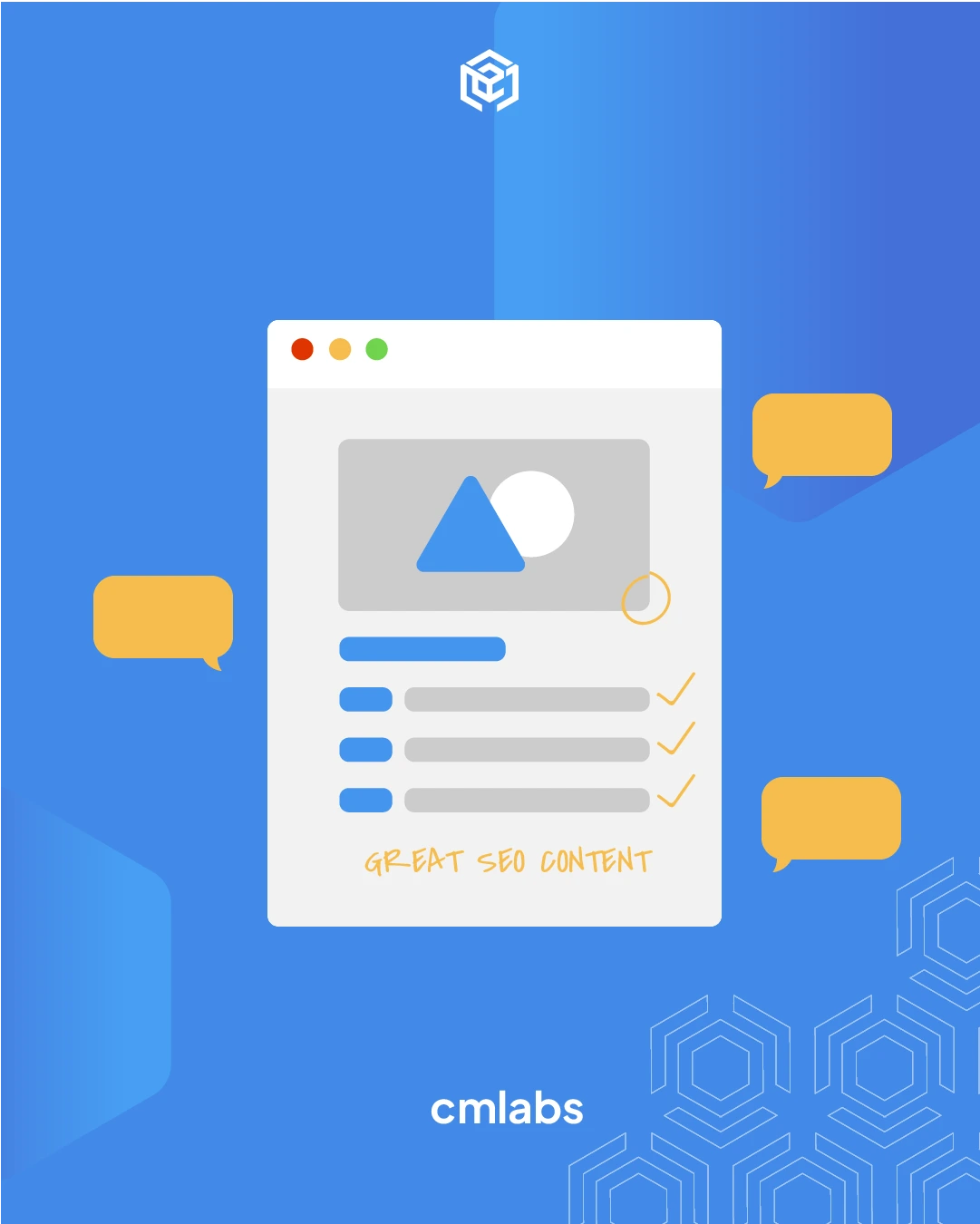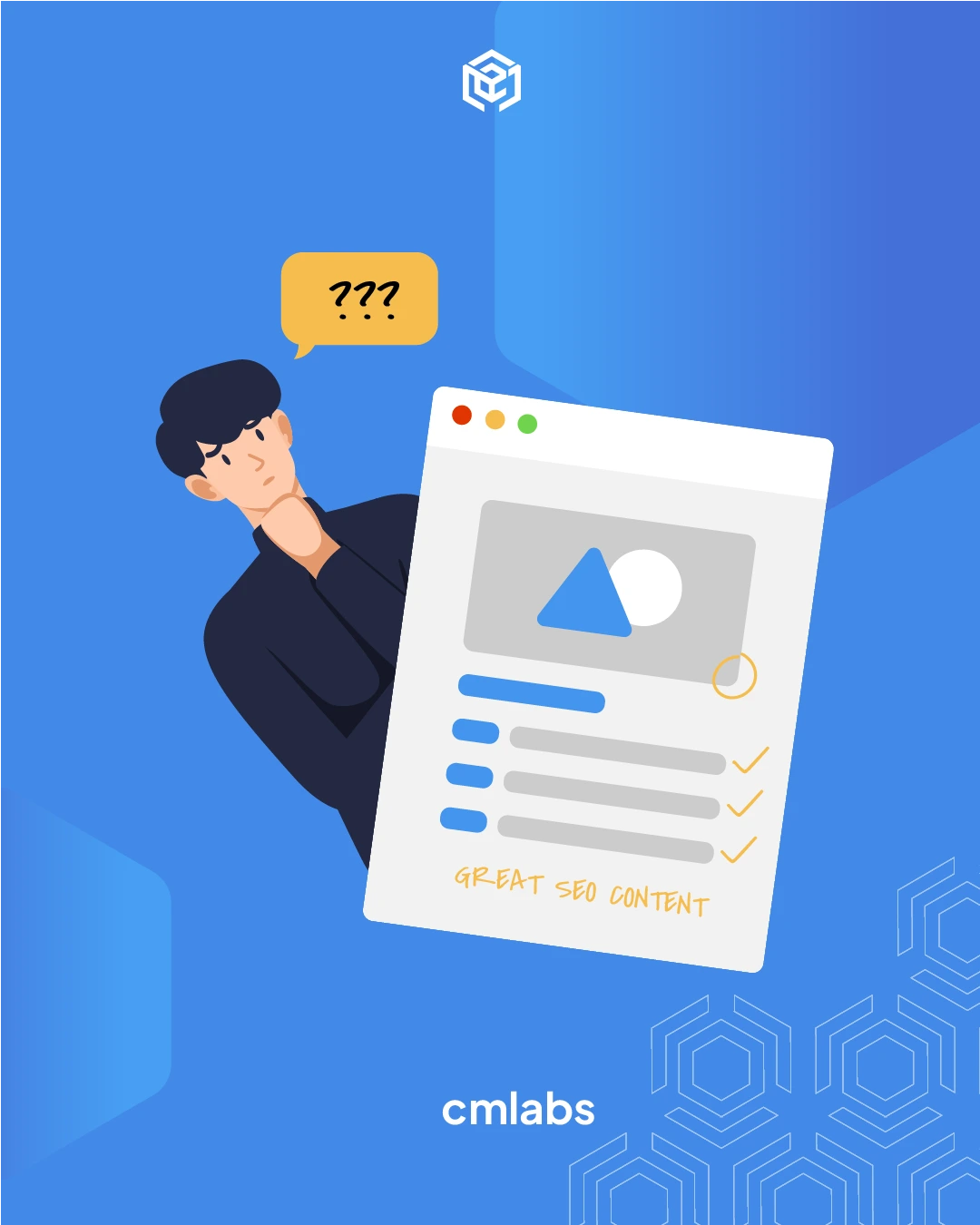We use cookies
This site uses cookies from cmlabs to deliver and enhance the quality of its services and to analyze traffic..
SEO SERVICES
Conduct in-depth technical website audits, strategically develop website projections, and increase your website authority.
ASO SERVICES
Elevate Your App’s Presence with Our Expert ASO Services – Boost Visibility and Drive Downloads!
WRITING SERVICES
We offer a variety of writing services to suit different business necessities. Reach broader audiences or lead specific industries? We've got you covered!
Get relevantly positive media exposure from bloggers and online publishers to increase your brand mentions on search engine results pages.
SEOlutions
A unified source of truth!
SEO & Digital Maternity Solution
SEO & Digital Maternity Solution: Leverage Cross-Platform Insights to Elevate Your Strategy with Expert Consultation
SEO & Digital Maternity Solution
Data Solution options:
Starting from Rp200 mio
Reinventing how a company get creative treatments
A new way to get your creative needs done. Agile team, efficient cost, and expedient way in a flexible yet scalable subscription plan!
Creative-as-a-Services
CaaS package options:
Based on Subscription
Pioneer in digital marketing software powerhouse
We’re excited to unveil our new range of Tech Solutions designed to drive your digital success. Whether you’re looking to enhance your website’s performance, streamline your tech stack, or unlock deeper insights from your data, we’ve got you covered.
Starting from Rp250 mio
Our Clients
Research and innovation center for digital transformation
Digital marketing combines technical skills and business knowledge at every stage. For marketing teams, improving budget management efficiency is crucial, as time is an invaluable resource that should be used wisely. At Sequence, we are dedicated to empowering you to optimize efficiency and strategic planning, ultimately enhancing the impact of your digital marketing efforts.
Subscription-based (IDR1,800/keyword)
Our Clients
BeyondSEO
References
SEO Tools for Webmasters
SEO Tools for Writers
SEO Tools
FIND THE SUITABLE PARTNERSHIP FOR YOUR COMPANY
Check out which cmlabs partnership program suits your company
WHITE LABEL SEO
for CorporateYour company is granted exclusive partnership rights to provide SEO services to our important clients, and we will provide a dedicated backend team to support your efforts.
AFFILIATE PROGRAM
for BizdevA new affiliate program is being introduced for skilled marketers and individuals with strong networks, offering commissions of up to 7% for generating profits independently.
DIGITAL AGENCY
for Marketing Partnerscmlabs is an essential partner for digital agencies, providing a unique selling proposition in Search Engine Optimization (SEO).
BACKLINK PARTNERSHIP
for Media / BloggerWe have a vast database of bloggers and media outlets across Indonesia, categorized by region and media type, giving our clients an edge in managing their media and SEO activities.
OFFICIAL TRAINING
We provide ongoing professional development and support to SEO professionals to ensure they are equipped to meet market demands.
JOIN AS CONTRIBUTOR
for Content WriterGreat opportunity for SEO Writers around the world. T&C applied!
ACADEMIC PARTNERSHIP
Through partnerships with universities in Indonesia, cmlabs has helped align academic curricula with industry demands.
Partnership
Sector & Industries
Tell us your SEO needs, our marketing team will help you find the best solution
As an alternative, you can schedule a conference call with our team
Schedule a Meeting?Contact
Survey
We use cookies
This site uses cookies from cmlabs to deliver and enhance the quality of its services and to analyze traffic..
Last updated: Mar 31, 2024

A rate card is a term used to define a document containing a list of prices for a service or digital campaign.
Currently, it is widely used by various industries, such as service providers, media, or even influencers with significant followers on social media.
The main function of this card is to detail prices. In this document, you will likely see how much budget needs to be allocated based on various factors, such as the type of advertisement, duration, and estimated reach or impressions.
However, this pricing document is not only used by content creators. So, who else needs it?
Let's delve deeper and learn more about rate cards in the article below.
In general, here are some parties that have a great urgency to create one:
In general, it is used to display the fees or prices that must be paid for a collaboration. However, it also has several other advantages, such as:
One of the main functions of this card is to enhance efficiency. In the marketing world, especially in the realm of endorsements or collaborations with external parties, a rate card can make the pricing discussion process more efficient and structured.
If an external party intends to purchase a service, place an advertisement, or engage in an endorsement, you only need to send them this document.
Another function of this card is to support transparency in collaborations. External parties can be aware that the prices and specifications of ads are standardized, making them less susceptible to manipulation.
Additionally, external parties can also view the cost structure and assess whether the rates provided are appropriate for each type of offer. This transparency also serves to strengthen trust and reduce the risk of misunderstandings in the future.
This document can make the entire booking process (for anything) more practical and efficient. External parties can refer directly to this card to see available advertising options.
Through this document, external parties can more easily compare service options or endorsement rates in a more structured manner.
This can prevent confusion and ensure that decisions made by external parties are more informed and aligned with their budget.
In some cases, it can also be used as a negotiation foundation. Although this card usually presents fixed rates, there is usually room for further negotiations, especially when external parties ask for long-term campaigns, bulk reservations, or special packages.
This type of pricing document is commonly used in the marketing world, particularly in digital marketing through social media.
Influencers or Key Opinion Leaders, especially, often use it to enhance the effectiveness of the endorsement process.
So, what are the elements that need to be included within an influencer rate card? Here are the details.
The first thing that should be included in an influencer rate card is information about the KOL.
This information may include social media usernames, follower count, average likes, engagement rate, impressions, and much more.
The profile can also include the KOL's niche or specialization, which is crucial as KOLs with status as coaches or experts in a particular field tend to have higher endorsement fees.
In addition to the profile, it also needs to contain explanations about the types of content that can be advertised.
With this information, brands interested in collaborating with KOLs can choose the type of content that is suitable for enhancing exposure in a digital campaign.
The endorsement budget will vary depending on the type of content to be ordered. For example, on Instagram, the endorsement rate for feed content will differ from the rate for reels content.
In addition, the rates could also be based on the effort required by the influencer and the metrics of success such as reach, impressions, and others.
If you are still unsure about the rates to set as an influencer, consider these steps:
In addition to content types, KOL specialists also usually decide the pricing or rates based on the duration of the content.
Generally, the longer the content duration, the higher the budget that needs to be allocated. If a brand wishes to establish a long-term collaboration, it should also include clear information and pricing for the duration of the digital campaign.
Now, let’s learn how to create this pricing document. Here is a guide on how to make a rate card based on different objectives and industries:
Here are some rate card examples from two common categories:
Influencer rate cards are often used in campaigns on social media. Below is the example:

In addition to endorsements, this kind of pricing document can also be used by service providers. Here is an example used by cmlabs as an SEO service provider.
WDYT, you like my article?
Couldn't find result for "Mulki" try to search with different keyword
Suggestion:
Tell us your SEO needs, our marketing team will help you find the best solution
As an alternative, you can schedule a conference call with our team
Schedule a Meeting?



cmlabs Jakarta Jl. Pluit Kencana Raya No.63, Pluit, Penjaringan, Jakarta Utara, DKI Jakarta, 14450, Indonesia
(+62) 21-666-04470These strategic alliances allow us to offer our clients a wider range of SEO innovative solutions and exceptional service.

Psst! Hey there, SEO Stats and Tools SEO company! If you've ever planned of conquering the Indonesia market, you've come to the right place!